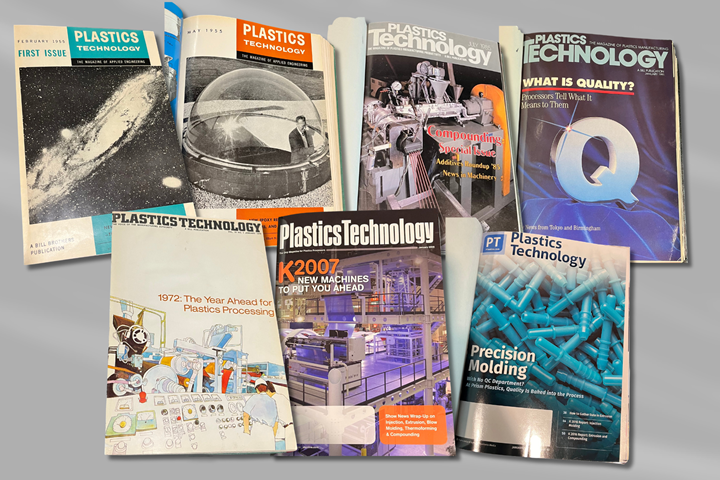70 Years...Still Going Strong
Plastics Technology is closing in on its 70th anniversary. Here are some of Editorial Director Jim Callari’s observations to commemorate the occasion.

If you take a look at the cover of the magazine, at the very top, you will notice that this issue has been marked Volume 70 of Plastics Technology. That means 2024 is the 70th year this magazine has been published on a continuous basis. This is not quite our 70th anniversary issue — that happens in October — but I think it’s a milestone significant enough to warrant a few words.
When I got into plastics journalism in 1988, there were maybe a dozen different publications serving various segments of this industry. There were a few devoted to the broad topic of plastics processing, including Plastics World, where I started. There were separate, more niche publications focused on compounding, part design and plastics packaging, as well as a new product tabloid devoted to equipment. There was even one ambitious publication that accepted no advertising and, in a fashion similar to Consumer Reports, evaluated various types of machinery and equipment.
Over time, some of these publications were sold, shuttered or otherwise faded away — including Plastics World — but others popped up. There was one (and briefly, two) devoted to injection molding. There was one (and briefly, two) focused on auxiliary equipment. None of these publications will find their way to your mailbox anymore.
In fact, in print form, there are now only three independently published monthly magazines serving the U.S. plastics market. There are lots of reasons for this. Mainly, the market has matured over the 36 years I’ve been a part of it. At one time, it was dominated by huge chemical companies that were seeming to develop new polymers every month, and invested big money in marketing and advertising to support these efforts. Over time, many curtailed their R&D, merged or were bought out, or got out of the polymer business altogether. To a less extent, the same kind of thing happened in machinery.
Of course, this is not a trend exclusive to plastics industry media. There are certainly fewer trade magazines now versus when I got into business-to-business publishing. Nor is it exclusive to business media, as we’ve all seen firsthand the decline in newspapers, news magazines and the like.
My point: in this media climate, there is something to be said about still being relied on as a credible source of technical information month in and out after 70 years. Thre is something to be said about stability. In its long history, Plastics Technology has been owned by only two companies: first Bill Communications and since August 2000 our current parent company Gardner Business Media. Since 1981, Plastics Technology has had but two chief editors; my colleague Matthew Naitove held the position from 1981-2009, and I have had it since.
There is also something to be said about being flexible and adapting to the changing needs of the audience. For many years, Plastics Technology was a magazine noted for doing deep dives on new technology. That was a perfectly justifiable position to have at the time, as companies supplying both materials and machinery were churning out new products regularly throughout the 1970s, 80s and even into the 1990s. But, while we certainly devote a lot of editorial effort each and every issue reporting on new products, the pace and magnitude of these introductions has slowed. And, in response, we shifted our focus to helping the reader in the here and now with articles on best practices, troubleshooting and processing tips.
There is also something to be said about not sitting on your laurels, as over the years we have expanded beyond a print magazine to a full-service media enterprise serving up information electronically as well as in-person with conferences and a trade show.
But enough about us. Fact is, we wouldn’t still be here if not for the loyalty of our audience. And for that I am humbled, and hope to continue delivering you the kind of information you rely on for decades to come.
Related Content
Bidding So Long — But Not Goodbye — To Plastics Icon Matt Naitove
After 51 years of contributing content, plastics industry stalwart will take a step back.
Read MoreSolve Processing Problems, Learn Tricks of the Trade: Register Now for Extrusion 2022
Tune into technical presentations that can help make you more money, and mingle with the world’s foremost authorities on extrusion processing.
Read MoreBenchmark Your Injection Molding Operation: Participate Now in Top Shops 2024 Program
You have until April 30 to complete an online survey to see how your molding business stacks up against others.
Read More50 Years...600 Issues...and Still Counting
Matt Naitove marks his first half-century in plastics reporting, with a few of his favorite headlines.
Read MoreRead Next
Why (and What) You Need to Dry
Other than polyolefins, almost every other polymer exhibits some level of polarity and therefore can absorb a certain amount of moisture from the atmosphere. Here’s a look at some of these materials, and what needs to be done to dry them.
Read MoreLead the Conversation, Change the Conversation
Coverage of single-use plastics can be both misleading and demoralizing. Here are 10 tips for changing the perception of the plastics industry at your company and in your community.
Read MoreTroubleshooting Screw and Barrel Wear in Extrusion
Extruder screws and barrels will wear over time. If you are seeing a reduction in specific rate and higher discharge temperatures, wear is the likely culprit.
Read More (2).jpg;maxWidth=970;quality=90)








 (2).jpg;maxWidth=300;quality=90)







 (1).jpg;maxWidth=970;quality=90)